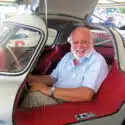Doug Nye: The fatal, chaotic scenes that ended city-to-city racing for good
Engineering endeavour and rampant testosterone reigned supreme in motor sport’s early city-to-city races
This motor sporting summer, with Ferrari once again winning Le Mans after 50 years and Max Verstappen matching – with notable ease – Ayrton Senna’s career total of 41 Grand Prix wins, also marks the passage of 120 years since what might be viewed as the original generation of motor racing enthusiasts saw ‘their world’ come to a ghastly, crunching, killing halt…
Frontline motor racing had developed really from its inception in 1895 as an unconcerned, by modern standards conspicuously anti-social, carefree game for moneyed toffs combined with ambitious, sales-hungry, commercial engineers and businessmen. It had also developed under a French lead as very much a motorised parallel of what had become the normal for major-league cycle racing, point-to-point, city-to-city, over hundreds of miles of barely regulated public roads. Where the cars came to be concerned, those roads might be variably closed to everyday ‘civilian’ traffic while the racers were unleashed along them, but generally traffic on rural European roads was light and very much comprising horse-drawn transport, meandering along at the mercy of what became very quickly the fiendishly fast, racing-dedicated horseless carriage.
The most prominent race organising body in that early racing world was the Automobile Club de France, and its pinnacle race of the 1903 season was to be a great cross-border international capital-to-capital blast from Paris to Madrid via Bordeaux and Vittoria, Spain. It was to start in the pre-dawn darkness of May 24, 1903, at 3.30am on the Route de Saint Cyr, Versailles. It then followed the finest-surfaced of French main roads at that time, through Rambouillet, Chartes, Châteaudun, Tours, Poitiers, Ruffec and Angoulême to Bordeaux – totalling 552kms, 343 miles – as an opening-day Stage 1.
“I hope the ban will be final and end these criminal activities”
The great race had been immensely well publicised, attracting massive public attention. Tens of thousands lined much of the route. Passage controls enforced neutralised road sections through town centres along the way, two and a half hours set aside to encourage safe passage. But once out on the open road it was free rein, and the largest-engined, most powerful (yet relatively stark and skeletally constructed) pure racing cars were averaging 140kph (87mph) on the loose and dusty sun-baked roads. On a timed section between Chartres and Bonneval, Louis Renault was reported to have averaged 150kph (93mph).
Crash structures, seat-belts, crash helmets, roll-over bars – even windscreens – all were conspicuous by near-total absence. Engineering endeavour and rampaging testosterone simply reigned supreme.
Fernand Gabriel’s blade-bodied Mors had started 82nd from Versailles, but he blinded his way through slower runners’ dust and reached Bordeaux in 5hrs 13mins 31secs, averaging nearly 106kph (65.8mph). This 1903 Paris-Madrid, Stage 1, race had produced stupendously high performance, fully demonstrating not only frontier automotive technology but extraordinary stamina, determination, skill and almost brainless courage on from the drivers and – surely boldest of the bold – their riding mechanics too.
But Bordeaux is where ‘the great race’ would stop for good. Near the village of Couhé-Vérac between Poitiers and Ruffec, Louis Renault’s dashing younger brother Marcel had tried to pass Leonce Théry’s little Decauville, dropped a wheel into the roadside gutter, spun and rolled, Renault being crushed fatally by his car. Claude Lorraine Barrow had swerved his big De Dietrich to avoid a dog and hit a tree. Both Barrow and his Spanish mechanic Pierre Rosez died. British driver Leslie Porter crashed his Wolseley into a farmhouse wall, mechanic Willie Nixon dying in the ensuing fire. Tourand’s Brouhot ran into the crowd near Angoulême, killing his mechanic and three bystanders. Georges Richard hit a horse and cart, sustaining severe injuries. E.T. Stead rolled his De Dietrich on top of himself, woman driver Mme du Gast stopping to render first aid, and after three hours drove on to finish 45th at Bordeaux. Only 113 other cars of the 224 starters made it that far.
It had been mayhem. France erupted, the government forbidding resumption. The Spanish followed suit. Stages 2 and 3 were banned. Competing cars were ignominiously horse-drawn next day to Bordeaux railway station, and returned to Paris by train. City-to-city racing was effectively banned from that moment. Better policed and marshalled circuit racing became the future – though some circuits were as much as 90 miles around.
Gustav Vischer, marketing director of Daimler Mercedes, wrote on May 25: “The frightful race Paris-Madrid is still fresh… I hope that the news published… concerning the ban of the race will not only be confirmed but that the ban will be final and put an end to these criminal activities once and for all.” It was and they were.
A different kind of motor sport replaced ‘The Heroic Age’ of city-to-city racing, but subsequently one or two exceptions would emerge. The Brescia-Brescia Mille Miglia was technically city-to-city, but a circuit nonetheless. And from 1927-57 it flourished, before – Paris-Madrid style – the organisers’ luck ran out. And in political terms, ever since, motor sport has been riding a razor blade.
Doug Nye is the UK’s leading motor racing historian and has been writing authoritatively about the sport since the 1960s

